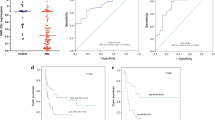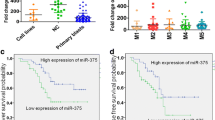Abstract
We attempted to construct a myeloid leukemia cell strain for stable overexpression and knock-down of miR-217 and explored the possible mechanism underlying miR-217 in chronic myeloid leukemia (CML). MiR-217 overexpression and the knock-down lentiviral vector with puromycin resistance were constructed and packaged within recombinant lentivirus. Stably transfected K562 cells were obtained through puromycin screening, and the qPCR assay detected the relative expression of the target gene. The proliferation, apoptosis, and methylation level of PER2 within cultured cells were detected using the CCK-8 assay, flow cytometry, and TaqMan real‑time fluorescence quantitative methylation-specific PCR. qPCR and Western blot detected the expression of miR-217-related genes within the constructed K562 cell model. Colony PCR and sequencing proved that recombinant lentivirus expression vectors pSE16 and pSE17 were correctly constructed. The lentivirus titer was 2.95 × 109 and 2.61 × 109 IU/mL. The miR-217 expression level was high in pSE5316-K562 cells, and that of the miR-217 sponge was high in pSE5317-K562 cells. Overexpressed miR-217 could inhibit the K562 cell proliferation and induce apoptosis. Inhibition of miR-217 enhanced the expression of DNMT3A, decreased the PER2 expression, and elevated the degree of PER2 methylation. The miR-217 overexpression and knock-down of the K562 cell line were successfully constructed, providing a tool for further exploring the miR-217 mechanism in CML. DNMT3A could be the molecular target of miR-217 by regulating PER2 gene methylation and getting involved with the occurrence and development of CML.



Similar content being viewed by others
Data Availability
The data that support the findings of this study are available from the corresponding author on reasonable request.
References
Xu, J., Wu, M., Sun, Y., Zhao, H., Wang, Y., & Gao, J. (2020). Identifying dysregulated lncRNA-associated ceRNA network biomarkers in CML based on dynamical network biomarkers. BioMed Research International. https://doi.org/10.1155/2020/5189549
Vener, C., Banzi, R., Ambrogi, F., Ferrero, A., Saglio, G., Pravettoni, G., & Sant, M. (2020). First-line imatinib vs second- and third-generation TKIs for chronic-phase CML: A systematic review and meta-analysis. Blood Advances, 4(12), 2723–2735. https://doi.org/10.1182/bloodadvances.2019001329
Gustafson, D., Fish, J. E., Lipton, J. H., & Aghel, N. (2020). Mechanisms of cardiovascular toxicity of BCR-ABL1 tyrosine kinase inhibitors in chronic myelogenous leukemia. Current Hematologic Malignancy Reports, 15(1), 20–30. https://doi.org/10.1007/s11899-020-00560-x
Wang, N., Mi, M., Wei, X., & Sun, C. (2020). Circadian clock gene Period2 suppresses human chronic myeloid leukemia cell proliferation. Experimental and Therapeutic Medicine, 20(6), 147. https://doi.org/10.3892/etm.2020.9276
Fu, L., Pelicano, H., Liu, J., Huang, P., & Lee, C. (2002). The circadian gene Period2 plays an important role in tumor suppression and DNA damage response in vivo. Cell, 111(1), 41–50. https://doi.org/10.1016/s0092-8674(02)00961-3
Shih, M.-C., Yeh, K.-T., Tang, K.-P., Chen, J.-C., & Chang, J.-G. (2006). Promoter methylation in circadian genes of endometrial cancers detected by methylation-specific PCR. Molecular Carcinogenesis, 45(10), 732–740.
Wang, F., Luo, Y., Li, C., & Chen, L. (2014). Correlation between deregulated expression of PER2 gene and degree of glioma malignancy. Tumori, 100(6), e266–e272. https://doi.org/10.1700/1778.19292
Samulin Erdem, J., Skare, Ø., Petersen-Øverleir, M., Notø, H. Ø., Lie, J.-A.S., Reszka, E., Pepłońska, B., & Zienolddiny, S. (2017). Mechanisms of breast cancer in shift workers: dna methylation in five core circadian genes in nurses working night shifts. Journal of Cancer, 8(15), 2876–2884. https://doi.org/10.7150/jca.21064
Yang, M.-Y., Chang, J.-G., Lin, P.-M., Tang, K.-P., Chen, Y.-H., Lin, H.Y.-H., Liu, T. C., Hsiao, H. H., Liu, Y. C., & Lin, S.-F. (2006). Downregulation of circadian clock genes in chronic myeloid leukemia: Alternative methylation pattern of hPER3. Cancer Science, 97(12), 1298–1307.
Jiang, H., Yang, X., Mi, M., Wei, X., Wu, H., Xin, Y., Jiao, L., Sun, S., & Sun, C. (2022). Development and performance evaluation of TaqMan real-time fluorescence quantitative methylation specific PCR for detecting methylation level of PER2. Molecular Biology Reports, 49(3), 2097–2105. https://doi.org/10.1007/s11033-021-07027-z
Jiang, H., Yang, X., Mi, M., Wei, X., Wu, H., Xin, Y., & Sun, C. (2021). PER2: A potential molecular marker for hematological malignancies. Molecular Biology Reports, 48(11), 7587–7595. https://doi.org/10.1007/s11033-021-06751-w
Xia, L., Ma, S., Zhang, Y., Wang, T., Zhou, M., Wang, Z., & Zhang, J. (2015). Daily variation in global and local DNA methylation in mouse livers. PLoS ONE, 10(2), e0118101. https://doi.org/10.1371/journal.pone.0118101
Saliminejad, K., Khorram Khorshid, H. R., Soleymani Fard, S., & Ghaffari, S. H. (2019). An overview of microRNAs: Biology, functions, therapeutics, and analysis methods. Journal of Cellular Physiology, 234(5), 5451–5465. https://doi.org/10.1002/jcp.27486
Di Leva, G., Garofalo, M., & Croce, C. M. (2014). MicroRNAs in cancer. Annual review of pathology, 9, 287–314. https://doi.org/10.1146/annurev-pathol-012513-104715
Mollaei, H., Safaralizadeh, R., & Rostami, Z. (2019). MicroRNA replacement therapy in cancer. Journal of Cellular Physiology, 234(8), 12369–12384. https://doi.org/10.1002/jcp.28058
Szafranska, A. E., Davison, T. S., John, J., Cannon, T., Sipos, B., Maghnouj, A., Labourier, E., & Hahn, S. A. (2007). MicroRNA expression alterations are linked to tumorigenesis and non-neoplastic processes in pancreatic ductal adenocarcinoma. Oncogene, 26(30), 4442–4452.
Panebianco, C., Trivieri, N., Villani, A., Terracciano, F., Latiano, T. P., Potenza, A., Perri, F., Binda, E., & Pazienza, V. (2021). Improving gemcitabine sensitivity in pancreatic cancer cells by restoring miRNA-217 levels. Biomolecules. https://doi.org/10.3390/biom11050639
Yan, J., Fang, T., Zhang, M., & Zhou, Q. (2021). LINC00467 facilitates osteosarcoma progression by sponging miR-217 to regulate KPNA4 expression. International Journal of Molecular Medicine. https://doi.org/10.3892/ijmm.2021.4859
Chen, G., Yang, Z., Feng, M., & Wang, Z. (2020). microRNA-217 suppressed epithelial-to-mesenchymal transition through targeting PTPN14 in gastric cancer. Bioscience Reports. https://doi.org/10.1042/BSR20193176
Huang, Z.-M., Wang, H., & Ji, Z.-G. (2021). Bladder mesenchymal stromal cell-derived exosomal miRNA-217 modulates bladder cancer cell survival through Hippo-YAP pathway. Inflammation Research: Official Journal of the EUROPEAN Histamine Research Society, 70(9), 959–969. https://doi.org/10.1007/s00011-021-01494-7
Mahdloo, T., Sahami, P., Ramezani, R., Jafarinia, M., Goudarzi, H., & Babashah, S. (2021). Up-regulation of miR-155 potentiates CD34+ CML stem/progenitor cells to escape from the growth-inhibitory effects of TGF-ß1 and BMP signaling. EXCLI Journal, 20, 748–763. https://doi.org/10.17179/excli2021-3404
Nishioka, C., Ikezoe, T., Yang, J., Nobumoto, A., Tsuda, M., & Yokoyama, A. (2014). Downregulation of miR-217 correlates with resistance of Ph(+) leukemia cells to ABL tyrosine kinase inhibitors. Cancer Science, 105(3), 297–307. https://doi.org/10.1111/cas.12339
Fabbri, M., Garzon, R., Cimmino, A., Liu, Z., Zanesi, N., Callegari, E., Liu, S., Alder, H., Costinean, S., Fernandez-Cymering, C., Volinia, S., Guler, G., Morrison, C. D., Chan, K. K., Marcucci, G., Calin, G. A., Huebner, K., & Croce, C. M. (2007). MicroRNA-29 family reverts aberrant methylation in lung cancer by targeting DNA methyltransferases 3A and 3B. Proceedings of the National Academy of Sciences of the United States of America, 104(40), 15805–15810.
Ren, R. (2005). Mechanisms of BCR-ABL in the pathogenesis of chronic myelogenous leukaemia. Nature Reviews Cancer, 5(3), 172–183.
Kim, S.-H., Menon, H., Jootar, S., Saikia, T., Kwak, J.-Y., Sohn, S.-K., Park, J. S., Jeong, S. H., Kim, H. J., Kim, Y. K., Oh, S. J., & Kim, D.-W. (2014). Efficacy and safety of radotinib in chronic phase chronic myeloid leukemia patients with resistance or intolerance to BCR-ABL1 tyrosine kinase inhibitors. Haematologica, 99(7), 1191–1196. https://doi.org/10.3324/haematol.2013.096776
Druker, B. J., Guilhot, F., O’Brien, S. G., Gathmann, I., Kantarjian, H., Gattermann, N., & Larson, R. A. (2006). Five-year follow-up of patients receiving imatinib for chronic myeloid leukemia. The New England Journal of Medicine, 355(23), 2408–2417.
Liu, X., Haniff, H. S., Childs-Disney, J. L., Shuster, A., Aikawa, H., Adibekian, A., & Disney, M. D. (2020). Targeted degradation of the oncogenic MicroRNA 17–92 cluster by structure-targeting ligands. Journal of the American Chemical Society, 142(15), 6970–6982. https://doi.org/10.1021/jacs.9b13159
Jiang, C., Yu, M., Xie, X., Huang, G., Peng, Y., Ren, D., Lin, M., Liu, B., Liu, M., Wang, W., & Kuang, M. (2017). miR-217 targeting DKK1 promotes cancer stem cell properties via activation of the Wnt signaling pathway in hepatocellular carcinoma. Oncology Reports, 38(4), 2351–2359. https://doi.org/10.3892/or.2017.5924
Chen, Q., Wang, P., Fu, Y., Liu, X., Xu, W., Wei, J., Gao, W., Jiang, K., Wu, J., & Miao, Y. (2017). MicroRNA-217 inhibits cell proliferation, invasion and migration by targeting Tpd52l2 in human pancreatic adenocarcinoma. Oncology Reports, 38(6), 3567–3573. https://doi.org/10.3892/or.2017.6036
He, S., Wang, Z., Tang, H., Dong, J., Qu, Y., & Lv, J. (2019). MiR-217 inhibits proliferation, migration, and invasion by targeting in osteosarcoma. Cancer Biotherapy & Radiopharmaceuticals, 34(4), 264–270. https://doi.org/10.1089/cbr.2017.2394
Flum, M., Kleemann, M., Schneider, H., Weis, B., Fischer, S., Handrick, R., & Otte, K. (2018). miR-217-5p induces apoptosis by directly targeting PRKCI, BAG3, ITGAV and MAPK1 in colorectal cancer cells. Journal of Cell Communication and Signaling, 12(2), 451–466. https://doi.org/10.1007/s12079-017-0410-x
Funding
This work was supported by the major scientific and technological innovation projects of the Shandong Province of China (Grant No. 2019JZZY011018) and the Yantai Science and Technology Plan Project of China (Grant Nos. 2019MSGY133 and 2019YD004).
Author information
Authors and Affiliations
Contributions
All authors contributed to data analysis, drafting, and revising the article, gave final approval of the version to be published, and agreed to be accountable for all aspects of the work.
Corresponding author
Ethics declarations
Conflict of interest
The authors declare that they have no conflict of interest.
Ethical Approval
Not applicable.
Consent for Participation
Not applicable.
Consent for Publication
Not applicable.
Additional information
Publisher's Note
Springer Nature remains neutral with regard to jurisdictional claims in published maps and institutional affiliations.
Rights and permissions
Springer Nature or its licensor (e.g. a society or other partner) holds exclusive rights to this article under a publishing agreement with the author(s) or other rightsholder(s); author self-archiving of the accepted manuscript version of this article is solely governed by the terms of such publishing agreement and applicable law.
About this article
Cite this article
Yang, X., Jiang, H. & Sun, C. Construction of Lentiviral Vector for miR-217 Overexpression and Knockdown and Its Effect on CML. Mol Biotechnol 65, 1253–1262 (2023). https://doi.org/10.1007/s12033-022-00615-9
Received:
Accepted:
Published:
Issue Date:
DOI: https://doi.org/10.1007/s12033-022-00615-9




